.svg.png.webp) | |
Native name | 日本貨物鉄道株式会社 |
|---|---|
Romanized name | Nippon Kamotsu Tetsudō kabushiki gaisha |
| Type | State-owned KK |
| Predecessor | Japanese National Railways (JNR) |
| Founded | April 1, 1987 (privatization of JNR) |
| Headquarters | 5-33-8, Sendagaya, Shibuya, Tokyo , Japan |
| Services | freight services other related services |
| Owner | Japan Railway Construction, Transport and Technology Agency (100%) |
Number of employees | 5,472 (as of April 1, 2021)[1] |
| Website | www |
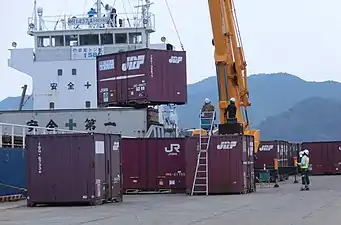
Japan Freight Railway Company (日本貨物鉄道株式会社, Nippon Kamotsu Tetsudō Kabushiki-gaisha), or JR Freight (JR貨物, Jeiāru Kamotsu), is one of the seven constituent companies of Japan Railways Group (JR Group). It provides transportation of cargo nationwide throughout Japan. Its headquarters are in Shibuya, Tokyo near Shinjuku Station.[1]
The Japan Railways Group was founded on 1 April 1987, when Japanese National Railways (JNR) was privatized. Japanese National Railways was divided into six regional passenger rail companies and a single freight railway company, Japan Freight Railway Company.
The company has only about 50 kilometers (31 mi) of track of its own, and therefore operates on track owned by the six JR passenger railways as well as other companies which provide rail transport in Japan.
Economics
In 2017, only about 5% of all freight in Japan is carried by rail but nearly all of that, 99%, is carried by JR Freight.[2] Trucks carry about 50% and ships about 44%.[2] JR Freight has seen its share of the freight market gradually decrease since 1993. In the 2010s JR Freight has been carrying more freight because of the decrease in the number of available truck drivers due to age as well as government policy to reduce carbon dioxide.[2] JR Freight has run a deficit for many years.[3]
Lines

While major part of the operation of JR Freight is on the tracks owned and maintained by other JR companies, JR Freight owns the railway lines (as Category-1 railway business) as follows:
| Line | Endpoints | Locale (Prefecture) | Distance (km) |
|---|---|---|---|
| Hokuriku Main Line | Tsuruga Station - Tsuruga-Minato Freight Terminal | Fukui | 2.7 |
| Kagoshima Main Line | Mojikō Station - Sotohama Freight Terminal | Fukuoka | 0.9 |
| Chihaya Yard - Fukuoka Freight Terminal | Fukuoka | 2.2 | |
| Kansai Main Line | Yokkaichi Station - Shiohama Station | Mie | 3.3 |
| Hirano Station - Kudara Freight Terminal | Osaka | 1.4 | |
| Nippō Main Line | Obase-Nishikōdai-mae Station - Kandakō Freight Terminal | Fukuoka | 4.6 |
| Ōu Main Line | Tsuchizaki Station - Akitakō Freight Terminal | Akita | 1.8 |
| Senseki Line | Rikuzen-Yamashita Station - Ishinomakikō Freight Terminal | Miyagi | 1.8 |
| Shin'etsu Main Line | Kami-Nuttari Junction - Nuttari Freight Terminal | Niigata | 1.8 |
| Kami-Nuttari Junction - Higashi-Niigatakō Freight Terminal | Niigata | 3.8 | |
| Shinminato Line | Nōmachi Station - Takaoka Freight Terminal | Toyama | 1.9 |
| Tohoku Main Line | Tabata Freight Terminal - Kita-Ōji Freight Terminal | Tokyo | 4.0 |
| Tōkaidō Main Line | Sannō Junction - Nagoya-Minato Freight Terminal | Aichi | 6.2 |
| Suita Freight Terminal - Osaka Freight Terminal | Osaka | 8.7 | |
| Uetsu Main Line | Sakata Station - Sakatakō Freight Terminal | Yamagata | 2.7 |
Rolling stock
As of 1 March 2017, JR Freight owns and operates the following rolling stock,[4] with most of the newer motive stock being exclusively built by Toshiba Infrastructure Systems & Solutions:
Diesel locomotives
- JNR Class DE10 B-C diesel-hydraulic locomotives
- JNR Class DE11 B-C diesel-hydraulic locomotives
- JR Freight Class DB500 B diesel-hydraulic locomotive
- JR Freight Class DD200 Bo-Bo diesel-electric locomotives
- JR Freight Class DF200 Bo-Bo-Bo diesel-electric locomotives
- JR Freight Class HD300 Bo-Bo, hybrid diesel-battery locomotives
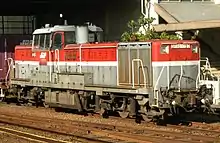 A Class DE10-1500 diesel-hydraulic locomotive in December 2009
A Class DE10-1500 diesel-hydraulic locomotive in December 2009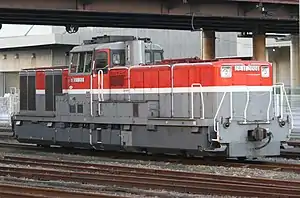 A Class DE11-2000 diesel-hydraulic locomotive in January 2011
A Class DE11-2000 diesel-hydraulic locomotive in January 2011 A Class DD200 diesel-electric locomotive in April 2020
A Class DD200 diesel-electric locomotive in April 2020 A Class DF200-100 diesel-electric locomotive in October 2011
A Class DF200-100 diesel-electric locomotive in October 2011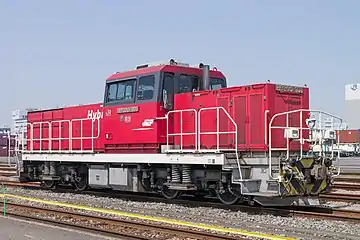 A Class HD300 hybrid diesel-battery locomotive in May 2013
A Class HD300 hybrid diesel-battery locomotive in May 2013
Electric locomotives
- JNR Class EF64 Bo-Bo-Bo DC electric locomotives
- JNR Class EF65 Bo-Bo-Bo DC electric locomotives
- JNR Class EF66 Bo-Bo-Bo DC electric locomotives
- JNR Class EF67 Bo-Bo-Bo DC electric locomotives
- JNR Class ED76 Bo-2-Bo AC electric locomotives
- JNR Class EF81 Bo-Bo-Bo AC/DC electric locomotives
- JR Freight Class EF210 Bo-Bo-Bo DC electric locomotives
- JR Freight Class EH200 Bo-Bo+Bo-Bo DC electric locomotives
- JR Freight Class EF510 Bo-Bo-Bo AC/DC electric locomotives
- JR Freight Class EH500 Bo-Bo+Bo-Bo AC/DC electric locomotives
- JR Freight Class EH800 Bo-Bo+Bo-Bo AC electric locomotives
 A Class EF64-1000 DC electric locomotive in July 2005
A Class EF64-1000 DC electric locomotive in July 2005 A Class EF65-2000 DC electric locomotive in February 2021
A Class EF65-2000 DC electric locomotive in February 2021 A Class EF66-100 DC electric locomotive in January 2006
A Class EF66-100 DC electric locomotive in January 2006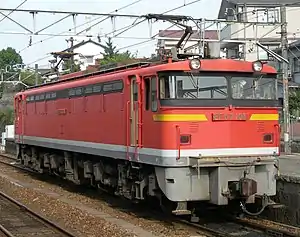 A Class EF67-100 DC electric locomotive in August 2009
A Class EF67-100 DC electric locomotive in August 2009 A Class ED76-1000 AC electric locomotive in March 2007
A Class ED76-1000 AC electric locomotive in March 2007 A Class EF81-450 AC electric locomotive in February 2008
A Class EF81-450 AC electric locomotive in February 2008 A Class EF210-100 DC electric locomotive in June 2009
A Class EF210-100 DC electric locomotive in June 2009 A Class EH200 DC electric locomotive in June 2007
A Class EH200 DC electric locomotive in June 2007 A Class EF510 AC/DC electric locomotive in August 2009
A Class EF510 AC/DC electric locomotive in August 2009 A Class EH500 AC/DC electric locomotive in December 2020
A Class EH500 AC/DC electric locomotive in December 2020.jpg.webp) A Class EH800 AC electric locomotive in July 2016
A Class EH800 AC electric locomotive in July 2016
Electric multiple units
- M250 series freight EMU
 An M250 series freight EMU in June 2007
An M250 series freight EMU in June 2007
Former rolling stock
- JNR Class ED62 Bo-1-Bo DC electric locomotives
- JNR Class ED75 Bo-Bo AC electric locomotives
- JNR Class ED79 Bo-Bo AC electric locomotives
- JR Freight Class EF200 Bo-Bo-Bo DC electric locomotives
- JNR Class DD51 B-2-B diesel-hydraulic locomotives
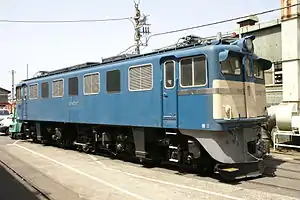 A Class ED62 electric locomotive in May 2007
A Class ED62 electric locomotive in May 2007 A Class ED75-1000 electric locomotive in March 2007
A Class ED75-1000 electric locomotive in March 2007 A pair of Class ED79 electric locomotives in June 2013
A pair of Class ED79 electric locomotives in June 2013 A Class EF200 DC electric locomotive in August 1992
A Class EF200 DC electric locomotive in August 1992 A Class DD51 diesel-hydraulic locomotive in August 2007
A Class DD51 diesel-hydraulic locomotive in August 2007
See also
References
- 1 2 Japan Freight Railway Company. "Corporate Overview". Retrieved October 21, 2021.
- 1 2 3 "Japan firms shifting to trains to move freight amid dearth of new truckers". The Japan Times Online. 17 January 2017. Retrieved 12 April 2017.
- ↑ WISETJINDAWAT, W.; et al. (2015). "Rare Mode Choice in Freight Transport: Modal Shift from Road to Rail". Journal of the Eastern Asia Society for Transportation Studies. 11: 774–787. doi:10.11175/easts.11.774.
- ↑ JR貨物 機関車配置表 [JR Freight locomotive allocation list]. Tetsudo Daiya Joho Magazine (in Japanese). Vol. 46, no. 400. Japan: Kotsu Shimbun. August 2017. p. 42.